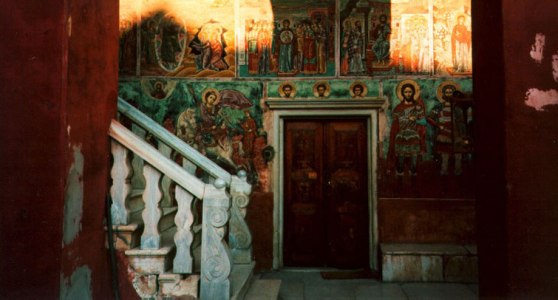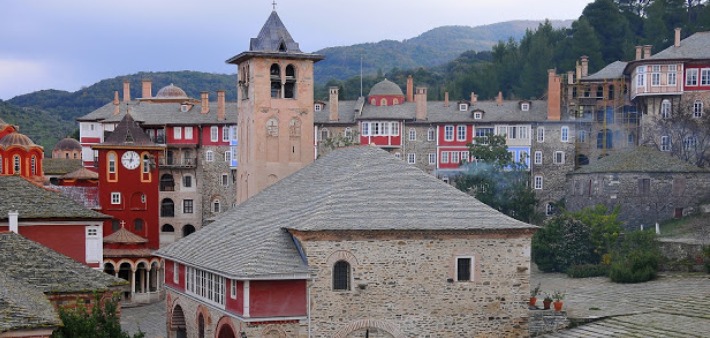
Email: filoxenia@vatopedi.gr
Vatopedi monastery is hierarchically the 2nd of the 20 monasteries on Mount Athos. It was buily in the late 10th century by three monks, Athanasios, Nicolaos and Anthonios, who were from Andrianopolis and had been disciples of St. Athanasios Athonite, the establisher of the coenobitic monasticism on the peninsula.
Buildings were built throughout the centuries up to 1900. Vatopedi is a big monumental compound, enclosed by tall wall, and its buildings are organized in a triangular shape. In the big yard lays the central church (Annunciation of the Theotokos), the dining hall made in the shape of the cross and a lot of chapels, the most significant of which being the Honorable Sash of the Theotokos.
In the central church, one may see the only walled mosaics found on Mount Athos, whereas its frescoes, painted in 1312, are one of the most notable monumental ensemble of the palaeologian renaissance. Parts of the frescoes are attributed to the renowned Thessalonian painter Manuel Panselenos.
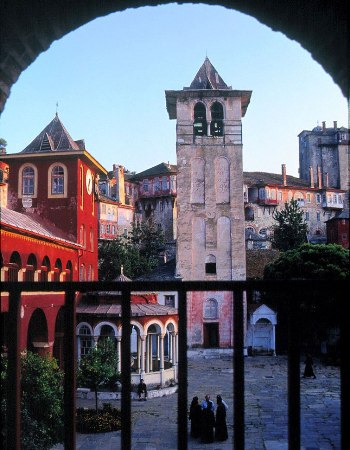
The monastery is inhabited today by c. 100 monks and during the last decades it blooms.
Besides the frescoes and mosaics, the monastery has also a great number of portable icons, manuscripts and sacred vessels of a unique value. Moreover, it has the most holy relics of saints on the mount, such as St. John Chrysostom’s incorruptible ear.
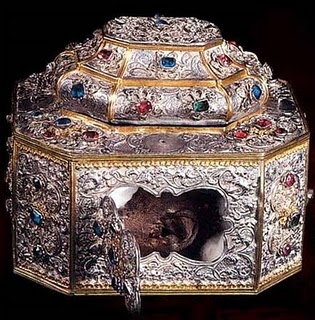
Among the about forty saints emerged in the monastery were the great theologian of the Orthodox Church, St. Gregory Palamas (14th c.), and the illuminator of the Russian people, St. Maximus the Greek (16th c.).
The founding of the Athonias Academy was made by the monastery and educationally strengthened the enslaved Greeks.
The Honorable Sash of the Most Holy Theotokos
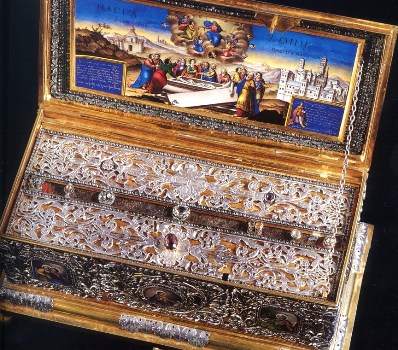
The grace-spurting Sash of the Mother of God, the holiest belonging of Vatopedi monastery, is the only arteface from the earthly life of Theotokos.
According to the Holy Tradition of the Church, the Most Holy Theotokos resurrected and ascended in body to heaven three days after her dormition. During her ascension, she gave her Honorable Sash to St. Apostle Thomas.
The Honorable Sash was according to the tradition made of camel hair by Theotokos herself. The byzantine empress Zoe, Leon VI the Wise’s spouse, embroidered the Sash with golden thread, due to her gratitude for her miraculous treatment; so it saved today but spit in three pieces.
Initially, the Sash was enshrined in Jerusalem and later in Constantinople, where in the 12th c. during Manuel I Comnenos’ reign (1143-1180), its official celebration on August 31st was instituted. Finally, Emperor John VI Cantacuzenos (1347-1355), who greatly hold the monastery dear, donated the Honorable Sash to Vatopedi. Today, the Sash is kept in a silver shrine bearing the image of the monastery.
The Honorable Sash has the exceptional grace to cure women’s infertility and cancer with a ribbon previously blessed on the holy relic and then worn by the infertile women or patients. The commemoration of the Placing of the Honorable Sash of the Most Holy Theotokos is held on August 31st.
Theotokos’s holy icons
As known, the most honored person on Mount Athos is the Most Holy Theotokos; in Vatopedi there are in total 8 miraculous icons of hers. Namely:
1.Theotokos Vimatarissa or Ktitorissa (of the Sanctuarier or the Founder): It was painted in the 10th century. This icon together with Great Constantine’s cross and a candle were cached in a well by Savvas the sanctuarier during an Arab incursion. Unfortunately, Savvas was captured and did not return. When he was released after 70 years, he proclaimed the place where he had cached the artefacts; when they opened the well, they found the icon and the cross above the water of the well and the candle still alight.
2.Theotokos Paramythia (the Comforter): It is a 14th c. fresco, which later relocated to a shrine. The icon is unusual, since Theotokos holds Jesus’s hand. The tradition says that once, while the abbot was giving the doorkeeper the keys, he listened to a voice saying “Don’t open the gates, but climb up the wall to repel the pirates”. The abbot wondered, took a closer look and saw Theotokos in the icon repeating the same message. Then, the divine infant replied, “Do not care, o Mother, for these sinners”, and tried to cover His mother’s mouth. But She caught His hand and repeated the warning; the monks defended the monastery and were finally saved.
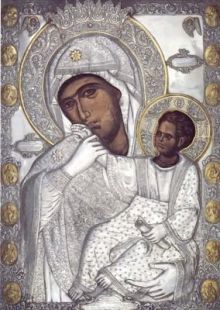
3.Theotokos Esphagmene (the Slaughtered): It is a 14th c. fresco. It took its name, when a red-blooded ecclesiarch was late for lunch and the diner-keeper refused to serve food to him. Enraged, the monk stabbed Theotokos’s icon on the face with a knife and shouted blasphemously. Suddenly, the icon started to bleed from where it was stabbed. The ecclesiarch spent the rest of his life in deep repentance. When he was digged out of his tomb, his whole body had decayed, but his hand remained incorruptible and so it is held up to the moment.
4.Theotokos Antiphonetria (the Replier): It is also a fresco in the Midnight service room. It is named so, because when Great Theodosius’s daughter visited the monastery, she heard a voice from the icon forbidding her to proceed, because she had violated the prohibition on entry for women.
5.Theotokos Eleousa (the Merciful): This icon is located in the same place as Theotokos Antiphonetria. It is dated back to the 15th century and it comes from Saint Andrew’s skete. This icon, Gerasimos Smyrnakis says, was formerly walled in a mosque in Constantinople, until some Christian craftsmans discovered it during reparations on the mosque and in 1893 sold it to the monastery’s steward.
6.Theotokos Elaeovrytissa (the Oilbearer): This is a portable 14th century icon found in the oil repository of the monastery. It’s shifted only on Renewal Friday. The tradition says that, when they ran out of oil, the oilkeeper and the cook started to quarrel because the former gave the latter no oil. The oilkeeper finally decided to give the cook as much oil as he asked for; then, one day the oil was over, but next morning all the vessels were found full, while one of them was overflowing.
7.Theotokos Pyrovoletheisa (the Shot): This icon was named so, when in 1882 a group of Turkish gendarmes entered the monastery. One of them shot the icon that prickle on the hand. Immediately after this happened, the gendarme lost his mind and the rest of them witnessing were frightened and got going.
8.Theotokos Pantanassa (Queen of all): This is a big portable icon painted in the 17th century. What is miraculous with this icon is that once a monk went to worship the icon and suddenly he saw the icon shinig and fell on the ground. After a while, he admitted he was doing sorcery, though he was a monk.
